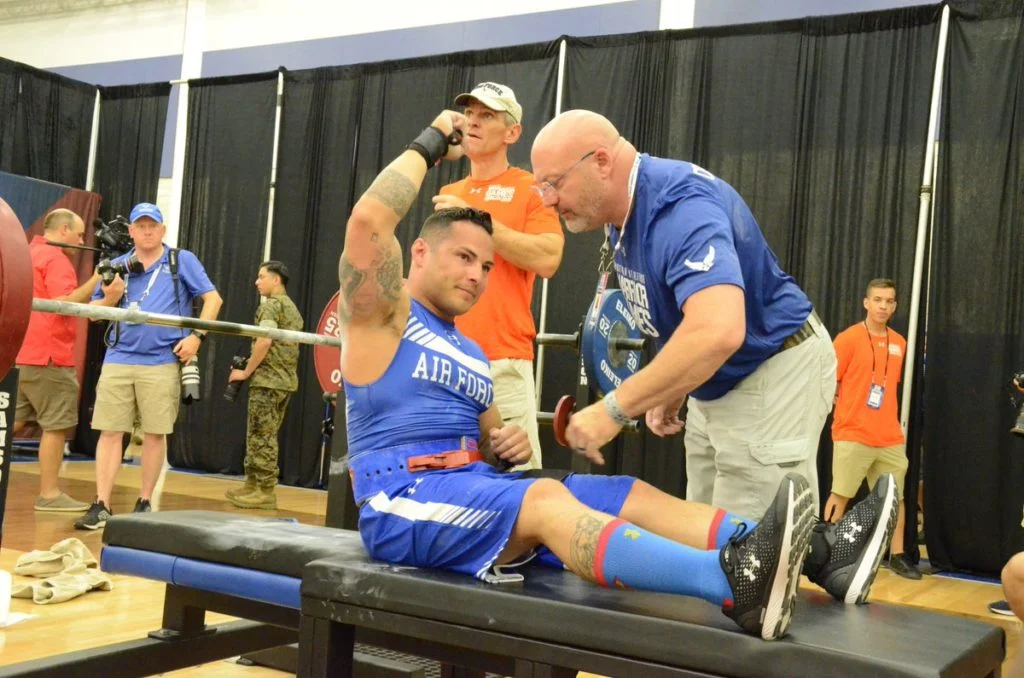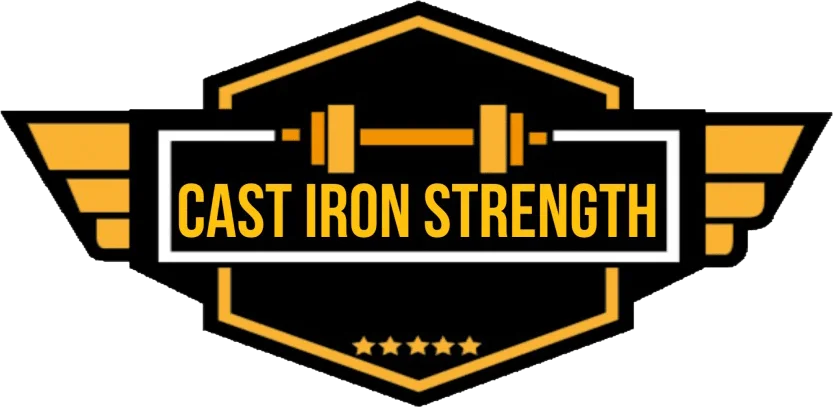Powerlifting is a strength sport that is made up of three competitive lifts.
Interested in trying or competing in powerlifting? Let us help!
The Squat
The first lift during competition is the squat. The squat is a lower body lift where the lifter walks the bar out of a rack. On the squat command, they then bend at the hips and knees until their hips are below the top of their knee. They then stand up against the weight. After standing up they then will re-rack the bar upon getting the Rack command.
The Squat tests the strength of the whole body and taxes the muscles of the thigh and core the most. It is an excellent lift for overall body strength and athletism and is used in pretty much every strength and conditioning program in the world.
The Bench Press
The second lift in a competition is the bench press. The bench press is a great test of upper body pressing strength. During the lift the lifter will lie down on the bench press they must have their feet flat on the floor, buttocks, shoulders, and head must be in contact with the bench during the whole lift. They will then take the bar out and start at arm’s length.
Upon receiving the start command the lifter will then lower the bar to their chest. They will pause the bar on their chest until the head referee gives the press command upon hearing the press command the lifter will then press the bar to lockout. Upon locking the bar out the lifter will then hold the bar at arm’s length fully locked out until they receive the rack command. Upon hearing the rack command the lifter will then put the bar back into the rack and the lift is completed.
The bench press is probably the most famous barbell exercise and is amongst the most effective upper body strengthening exercises. When it comes to developing the pressing muscles of the upper body (chest, triceps, and shoulders) the bench press is the ultimate test and developer of these muscles.
The Deadlift
The final lift during a powerlifting competition is the deadlift. The deadlift is probably the simplest and most grueling of the three lifts. The bar starts on the floor. The lifter must lift the bar from the floor to being fully standing. They can use either sumo (hands inside of the legs) or a conventional (legs outside of the hands) stance.
Upon successfully lifting the bar from the floor to being fully standing the lifter will then receive the down command from the head referee. They then must lower the weight to the floor without dropping it thus completing the lift.
The deadlift involves pretty much every muscle in the body to some extent. The muscles of the posterior chain (back of the body) are taxed the most developing strength in the hamstrings, glutes, lower and upper back through the whole lift. The deadlift is an incredibly effective lift when done right developing whole-body strength and explosive athletic ability.
What is powerlifting training like?
Powerlifting training is what most people think of when they think of strength training. Most of the most popular online gateways to strength training use powerlifting training (starting strength, stronglifts, Wendler’s 5/3/1 to name probably the 3 most popular gateways to strength training) powerlifting training is training that revolves or prioritizes getting stronger at Squat, Bench and Deadlift. You don’t have to be competing in powerlifting to be doing powerlifting training.
Powerlifting training can be done 1-7x per week depending on the time you have to give to it and the results you want to get out. For most people training 3-4x per week will see the best results. When you start training more than 4x per week (5-7) you can see a better performance or add in more training volume and variety but the amount of gain you can expect to see after 4x per week training drops off pretty rapidly.
Generally, powerlifting training is done as either a full-body training split (training the whole body in one session) or doing upper/lower training splits (training the upper body one day and then training the lower body the next day). During sessions lifter will normally focus on 1-3 main lifts normally variations or assistance lifts for the big three (squat, bench, and deadlift) after which they will perform assistance work.
Assistance work is designed to help balance out the powerlifting training hitting muscles and strengthing up parts of the body that the main lifts don’t really target or focus on. For example here are some common uses for assistance lifts
- Rows and Pulldowns or pull-ups to train the muscles of the back
- Step-ups or lunges to train muscles of the thigh and balance
- Lower back and abdominal exercises to strengthen up the core/trunk
- Rotator cuff work to strengthen up the smaller muscles of the shoulder that aren’t used to lift heavy weights
This kind of training helps to improve performance indirectly and to prevent injury and imbalance directly. You can normally expect to spend about 45-90 minutes in the gym for a powerlifting workout. You will feel challenged and fatigue like you have never experienced in normal sports and exercise training.
There is a great sense of joy and achievement seeing yourself working with heavier weights with exercises. Lifting is a rabbit hole in exercise like no other you have constant objective feedback in the form of weight on the bar telling you how things are actually going. You have the constant subjective feedback of how things are feeling and how they look in video or how people are telling you they are looking. You have a constant mental battle with yourself, dealing with your own negative thoughts and self-doubt, the fear of new heavyweights and the joy of overcoming these obstacles. It really is a wonderful and horrible master all at once.
Interested in trying or competing in powerlifting? Let us help!

What can powerlifting training do for me?
If you are looking for a way of training that will develop your overall body strength then there really isn’t anything that is as widely available and effective as powerlifting. You could argue that strongman developed more total strength but it isn’t as widely available (not every gym is equipped for strongman) and you could argue that weightlifting developed you more as an athlete (weightlifting isn’t as accessible if you don’t have a competent coach it is very difficult to self teach). However, powerlifting hits a sweet spot of being easy to access the equipment as pretty much every gym these days has a rack, bench, barbell, and weights. The technique in powerlifting is also simple enough that you can self teach yourself to a reasonable level of competence but deep enough that they can take a lifetime to truly master.
Physically strength training can offer much if not all of the health benefits of other exercise kinds such as cardio or stretching but it also provides a host of benefits that those kinds of exercises can’t provide
- Improved longevity and general well being
- Increased in mental health and perceived well being
- Increase in cognitive function
- Improved heart health positive effect on cholesterol
- Increase bone mineral density
- Decrease in risk of falls and breaks
- Decreased risk of injury in general
- Increase in muscle function
- Increase in flexibility and mobility
- Increase speed and power of muscles trained
- Increased ability to adapt to other training
- Increase in running and movement economy
- Increase in sports performance
- Increase retention of lean mass as you age
- Increased function and mobility as you age
The benefits of strength training really are massive the above doesn’t provide every benefit and depending on your goal and what you want to achieve you can bend strength training to your will and make it more specific to your goals or desired outcomes.
If you want to take up a new hobby that will help to challenge and develop you, which is engaging, challenging and fun then you could do a whole lot worse than trying out powerlifting or powerlifting training.

